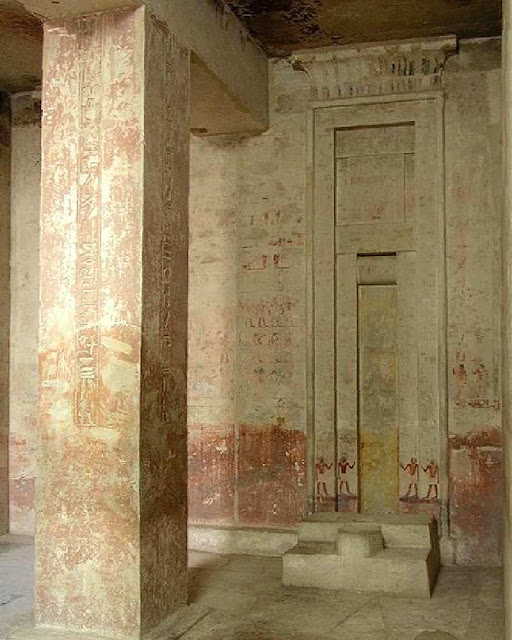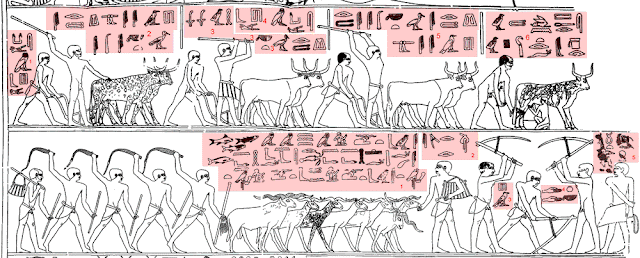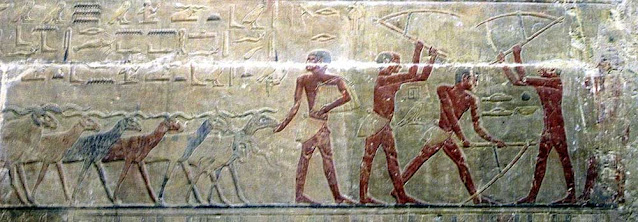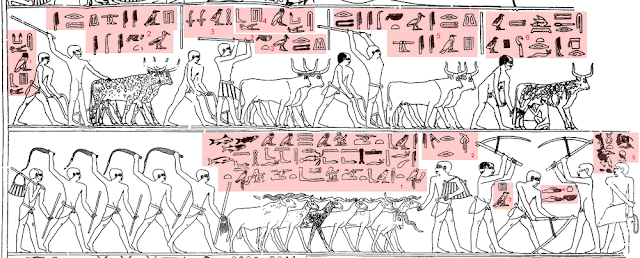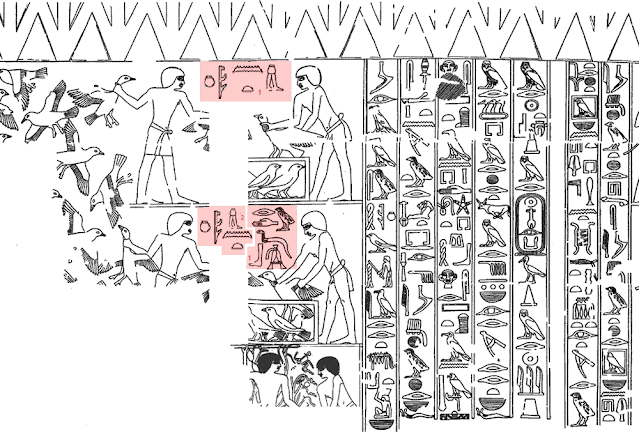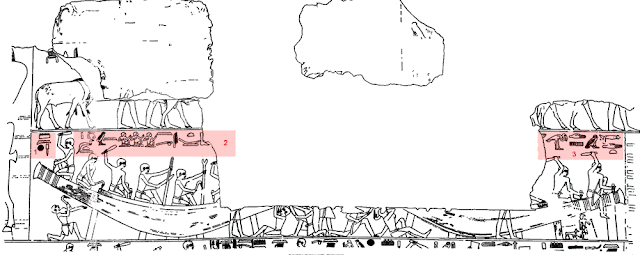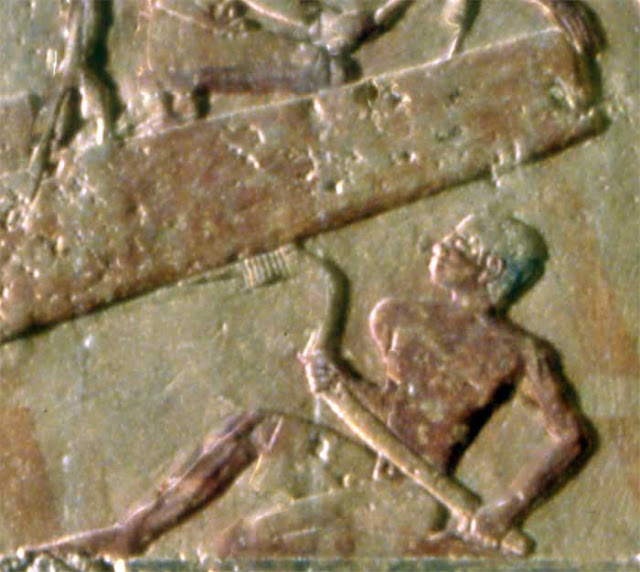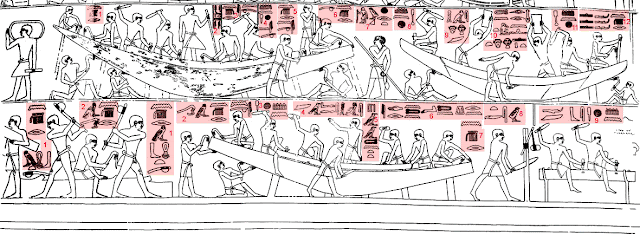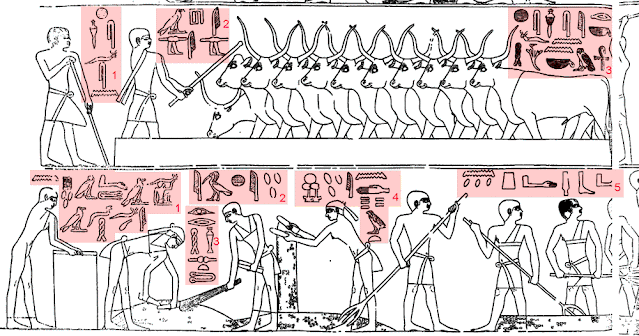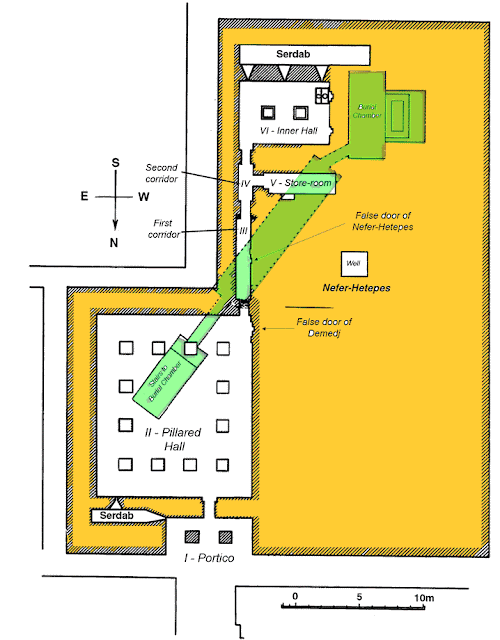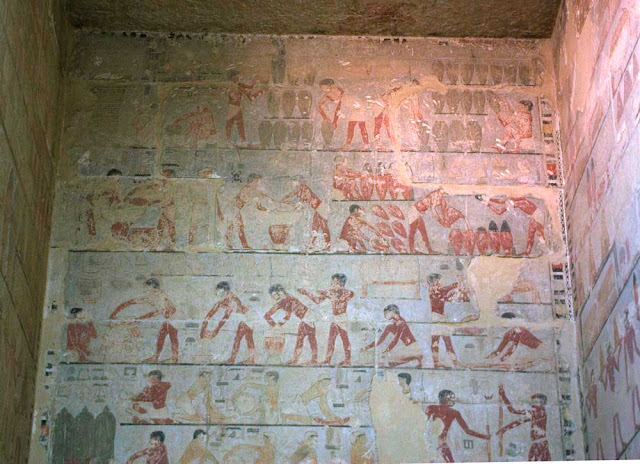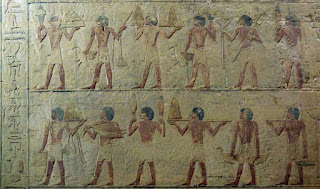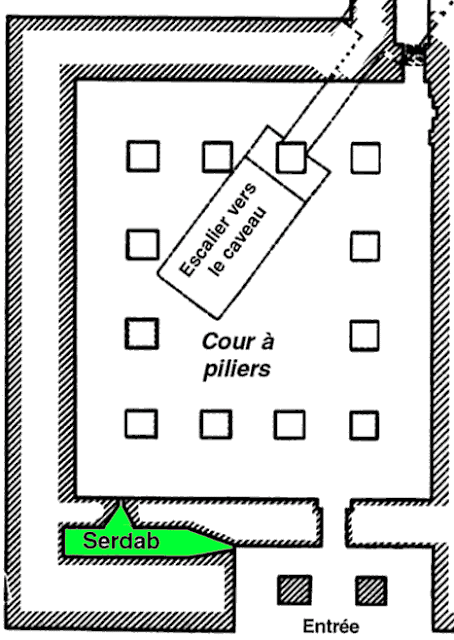The wall measures 1.55m wide by 4.50m in height, of which the upper 2.75m is decorated. It contains scenes with seventy-four characters distributed in seven registers of identical height, which gives an impression of continuity. The register at the top (N°7), is occupied by the manufacture of pottery, the bottom register (N°1), represents the accounting of the records. In the middle is found, on registers N°2,3, and 4, the manufacture of bread; whilst on registers N°5 and 6 is the manufacture of beer.
1) - Pottery : Register 7
On this register, the highest, is displayed the manufacture of the pots, indispensable to the cooking of bread and to the brewing and storage of beer, activities which are always intimately connected.
On the left stands a large oven, striped horizontally, which could suggest the idea of plates on which pots are placed to bake. A man is seated in front of the opening and fans the flames, whilst raising his hand to protect his face from the heat. Above him it states, 1: "heating the oven".
Next comes all the stages of manufacture, with, in first place a turner, who is seated low to the ground. The pot is turned on a table whose disk is rotated by the action of his right hand, whilst the left hand models the opening of the pot This could be the oldest depiction of a potter's wheel of ancient Egypt . The legend specifies the nature of the task, 2: "turning the Knw pots"
. The wet vessels are represented stacked above, before being baked. According to Egyptian perspective, it is necessary to understand of course that they are carefully aligned.
Next comes the scenes of finishing: two potters stand back to back in front of tall jars which they either inspect or correct minor flaws. The two legends, which are also placed back to back, having the determinative "jar" in common at the middle, 3: "turning a jar" /
"modelling a jar"
. A seated man, on the right, holds aloft with one hand a container, whilst with his other he plunges it into the opening, smearing the inside with a product named "sin"
(this product is not named in the tomb of Ty, but it is known from other tombs). It is very probably a form of clay, intended to seal the jar, or a glaze. Finally, a last character, on the left, arranges the finished pots on shelves.
2) - Manufacture of bread : Registers 4,3 and 2
Register 4
This has, at its centre two sub-registers.
The beginning of the manufacture is located at the left extremity, where the granary stands, consisting of three cylindrical silos with pointed tops, resting on a pedestal so that they are not in contact with the ground. At their base is an opening through which grain can flow. The text above (1) them states: "the granary which is in the house of grains, under the leadership of the team of the month"
. The seated scribe (in the top sub-register) is evidently part of the work force. His role is to record the quantity of grain taken by the man crouching at the foot of the front silo (in the bottom sub-register).
At the right-hand side stand two men, face-to-face, using long pestles to grind the grain, to detach the husk from it, and to begin the crushing. Above them, the legend (7) says: "pounding"
, which is done by each man in turn, one regulating the alternation of the pounding, with (5) "come down now!"
, whilst the other confirms this with (6) "I've done it".
At the centre of both sub-registers are some women (note their yellow skin, very different from the brick-red of the men), one of whom is (2) "measuring the grain"
(which has been ground), which is poured for a sifter who is provided with a round sieve to remove the husk from the actual grain, (3) : "sifting the grain"
. This followed by grinding into flour, (4) "grinding the grain".
Register 3
This is again, in part, made up of two sub-registers, divided into two more or less equal parts by a man standing near the centre at the height of the full register. His image is partially destroyed. He is, according to the text (2) above him: "the person responsible of the workshop"
, who leans forwards on to a staff which is invisible today, this is the classic stance of the supervisors to the Old Kingdom.
On the left pair of sub-registers, six women are grinding the grain on their millstones, which has come from the previous operations and which is in containers and bags opposite them. At the right edge of this section, two women (one in each sub-register) seated on the floor and who are occupied with (1) "sifting the flour"
. Their oblong sifter separates the fine flour from the coarser flour, which will be returned for further grinding, and so forth.
On the right-hand side of the person in charge, two other women sift the flour whilst the following four are occupied with grinding. At the extreme right, the two last are clothed in dresses with shoulder straps (all others have a naked chest). This pair collect the finished flour and put it into containers.
Register 2

This register covers the baking of the bread. The Egyptians could bake bread in an oven or directly over embers. But most of the time, they used a wide terracotta vessel to mold the bread "bedja" (there was also a "setchet" mold, to be discussed below, and an "aparet" mold). This container was first heated, then, it was placed on the ground and filled with dough, whilst a second mold, placed upside-down covered the first. [N.B: an analogous utensil named "the diable" existed which was used to cook potatoes or chestnuts]. The scene is represented as follows: ten pots (and not nine as is written in the literature, based on Montet) are built into pyramid form around a central hearth. This is stirred by the seated woman with her right hand (provided with a poker), whilst protecting her face with the left hand. Above her, the text (1) states: "heating the oven"
. Standing in front of her is another woman who arranges the pots, openings downwards, with her text (2) : "checking the oven"
. On the right of the register, can be seen a similar scene with the same legends, but this time it is a man who stacks the pots and also a man who stirs the embers of the fire.
The middle of the register is again sub-divided. On the lower sub-register, on the left, a wide pot-bellied vessel contains (3) "dough"
. The woman bending with her back to it, her hair enclosed in fabric wrap, is occupied (4) "pouring the dough"
into a hot mold which has come out of the oven. Opposite her, another, but with a close cropped wig, is occupied (5) "kneading the dough"
. Another couple carry out a similar action behind them, the one on the left pours into a wide container on the ground a preparation with the name of "hesa", of which Montet demonstrated that it refers to leavened bread. Finally, the worker on the right (4) is "pouring the dough"
in the bedja pots. Two among them are closed, they contain the dough which is therefore already cooking.
In the upper sub-register, of the first two women, the first bending and the other seated, check with the help of a stick to see if the bread is cooked; the action is commented thus, (6) "checking the bread"
. Following this, two seated men strike the bottom of a pot, as the text (7) states: "making the bead fall"
, which will then be placed in a basket.
As a small aside, the designer of the wall has included, on the left side of the upper sub-register, a child who feasts on a fragment of freshly baked bread.
3) - Brewing of beer : Registers 5 and 6
An activity fundamental to the daily life, the manufacture of ancient Egyptian beer is however still not fully understood. No tomb includes a complete illustration of the - long - process, and the explanations proposed for it are from scenes coming from different places. Even a series of representations as outstanding as those found in Ty is no exception to the rule."It is certain that ancient Egyptian beer was made using bread and a fragrant liquid; the mixture was brewed on a filter and the liquid collected was the one that was drunk under the name of beer (heneqet). P. Montet firstly assumed that this liquid was made from dates." (Vandier)
Register 5


This is the first of the two registers dedicated to the manufacture of beer. The beginning of the scene is located on the right: a man stands withdrawing the contents from a very large jar, laying horizontally on several supports. It seems to contain something made with grain, probably cereals germinated under special conditions known as malting (see image opposite). Below, a kneeling man is in the process of (8) "spreading"
this malted grain, which has the effect of stopping the germination. The scene is described thus: "kneading the uncooked bread"
. In front of him another person is occupied (6) "moulding the loaf"
to form oblong lumps, which are transported on a tray. In front, is a man who, leaning forwards, stirs a mixture in a large container, which rests on a pedestal. The scene is described by the word (5) "dnt"
, which Montet has not included, but which according to Wörterbuch 5,464-2 could mean "soaking"
, probably referring to the soaking in water of the previously moulded lumps of bread, and to mix it in the deep container to make a liquefied dough, later seen being poured from a jar. If this is the case, it seems difficult to see why the dough had to be moulded into the shape of bread.
At the left end of the register, some moulds are heated, and the scene looks like the one of the manufacture of bread, but the vessels are not 'bedjas', as for the bakery: they represent beer vessels ("sSt"
or setchet), these are wider and not as deep. It is a man who, this time, stirs the ashes, whilst protecting his face. The legend (1) specifies: "firing the beer vessel"
. In front of him another man takes a vessel, withdrawing it (presumably with hand protection), the legend above (2) states: "taking the bread-dough"
. Behind him, one of his companions pours the now fluid dough into one the moulds which has just left the oven. The legend (3) explains: "pouring the dough"
. The cooking could not be too intense, because of the risk of destroying the malt enzymes. The dough having been very fluid, the breads were more friable, which facilitated their subsequent crumbling.
Register 6
The bread, having been manufactured, the actual brewing can begin. The loaves are crumbled and the fragments soaked in a large wicker container, with water and the rest of the uncooked bread, the mixture being stirred by two men. The basket sits on a large pot fitted with a flared spout in which the mixture flows when it is sufficiently fine. On the left, the mash is added from jar. The (4) "scribe of the warehouse"
, with his work instruments under his arm, stimulates the brewers with the words (5) "make it ready!"
to the workers in front of him, and (3) "make it quickly!"
to those behind him. This is to encourage them not to waste time because some of the ingredients were quite perishable. The first text (1) says: "straining"
(or filtering the brew), the second (2) is "pouring the mash"
, ("sgnn" =mash).

A man seated on the right of the brewers adds a final touch to the jars which are going to receive the beer, whilst checking the coating inside one of them (see image opposite). The containers are then raised vertically (as seen to the right) in a support. In this next scene can be seen one of the brewers pouring the previous preparation in one them, using a vessel with a spout, text (7) : "filling the jars"
. Immediately, another worker closes the container using a flat plug, which will be topped with a cone made of clay (both are black). The action is described (8) as: "closing the jars".
Above, to the left, a man sits in front of four closed jars; his is (6) : "guaranteeing the authenticity"
by labelling the jars, indicating the quality the beverage, place and date of manufacture.
4) - Recording accounts : Register 1
(Line drawing and photo : MO-R1)
On the first register (at the bottom of the wall), officials give their accounts to the scribes who record the results, which will be subsequently communicated to Ty. The texts of this register were especially difficult to render.
• On the right (see tat-026) are seated the scribes, with firstly a character designated (5+2) as "the steward, Sheset-seped"
. He writes using a stylus on the papyrus which is open on his knees. At his feet, his palette rests casually against a box, in which are arranged scrolls of papyrus, which are arranged by size. It is the role of (4) "the archivist, Imem"
, whose name and title are at the right edge of the register, to take care of the scrolls, one of which is in his hand. Behind the steward, the two scribes are identified as (7) "the scribe, Hen"
and (6) "the scribe, Hemmu"
. The text (3) which runs over the three of them states: "Receiving the reports of the domains of the foundation".
• On the left (see tat-027), just in front of the steward, stoops a man identified as "the measurer, Neferhy"
who plunges his measuring instrument into a vessel. Seated behind him is "the inspector of the priests of the ka, Ini"
. Then, stooping as a sign of respect, comes a foreman with the name of "Niankh-Bastet"
, described as "powerful of voice"
: perhaps he announces, in a loud voice, the nature of the products to be recorded, as well as their quantity. At the extreme left is a scene which it may be assumed was created to amuse the designer of the wall: "The guardian, Iunenek"
administers a beating to a (1) "Head of the warehouse"
. The designer had probably had the opportunity to receive a beating from various supervisors or managers, and was not sorry to perpetuate the spectacle.
Located against the left edge is a bag (?), very tall and narrow, whose nature remains mysterious.
















